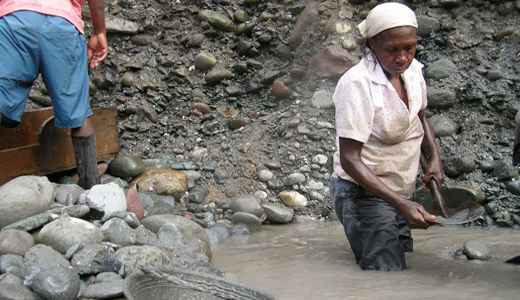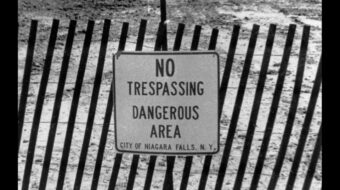
Death threats have been made against U.S. organizations working in solidarity with Colombia. On October 10, the Washington Office on Latin America (WOLA) received its third death threat this year from Colombian “Black Eagles” paramilitaries. Responding to WOLA’s complaint, Angelino Garzón, Colombia’s Vice President, expressed “profound concern” and promised protection for human rights defenders. WOLA has long backed the Afro-Colombian gold mining community of La Toma, in the Suárez municipality in north Cauca, a community that was established by African slaves and escaped slaves from 1636 on. The threats were apparently made in response to this support.
WOLA had been preparing for an October 25 gathering in Washington to honor the Association for Internally Displaced Afro-Colombians (AFRODES), based in the United States and Colombia. The program included leaders of Colombia’s Black Communities Process (PCN). Top billing for AFRODES and PCN may have riled the paramilitaries.
These organizations take the death threats seriously. This year in Suárez, eight miners were killed in April and five more in July. An AFRODES activist was assassinated following earlier threats this year and there was a failed attempt on another activist in Cartagena on October 13.
Why are the Afro-Colombians of La Toma and their supporters under attack? Gold mining companies have descended on the area, among them South African-owned Anglo Gold Ashantio. Last year 1300 Afro-Colombian families in La Toma received eviction notices. Longtime efforts in La Toma to preserve community governance and communal land rights, both constitutionally sanctioned, had come down to fending off gold-mining impresario Héctor Jesús Sarria’s claim to 250 acres. In a package that included La Toma, the Colombian government had privatized 25,000 acres in the Suárez municipality, or two thirds of that municipality’s land.
Environmental concerns also rank high for those resisting industrialized, open pit gold mining. A lawyer complained that corporations “seize a mountain, dynamite it, and go on to washing with cyanide to obtain gold.” Tons of gold are removed every day. In sharp contrast the daily yield for the local artisanal miners seldom exceeds 100 kilograms. And trees are left standing, the lawyer said.
Angela Davis’ visit to La Toma on September 18 helped focus worldwide attention there. César Rodríguez Garavito’s wide-ranging interview with Davis took place “only a few steps from gold mines the black communities have worked in artisan fashion for over three centuries.”
Asked how La Toma related to “other causes you have defended,” Davis declared, “Capitalism’s obsession with profit and disregard for humanity, culture, and history are clearer here in La Toma, in struggles for ancestral lands, than in any other part of the world. Afro-Colombian and indigenous peoples trying to preserve connection with their lands, which is also connection with their history and culture, are being trampled on by transnational corporations.”
Davis denounced “U. S. support for the creation of a repressive apparatus in Colombia similar to the U.S. prison-industrial complex.” She castigated Washington’s certification September 15 of Colombian human rights compliance, required for continuation of military aid.
In Cali she told interviewer Jaime Arocha that, “My visit to La Toma was one of the most intense of my entire life. If the people of La Toma are successful,” she said, “struggles will go on to liberate indigenous and the Afro-Colombian peoples in the Pacific [Coast], in the Caribbean, and elsewhere.”
Last year the Colombian government agreed before the Inter-America Commission of Human Rights to review mining permits granted without the La Toma Community Council’s consent. So far, this has not happened.
This year PCN and AFRODES are seeking a judgment from the UN Human Rights Committee, due December 20, regarding U.S. government complicity with Afro-Colombian repression. Their plea covers Plan Colombia, the U.S. role in internal armed conflict, and U.S. support for Colombian militarization. They allege U.S. intervention in Colombia fosters discrimination, displacement, violence, and subjugation of African descended women.
The complainants call upon the UN to recognize enhanced vulnerability of Afro – Colombians to U.S. meddling due to already dire circumstances. Almost half of the Afro-Colombians (who make up 26 percent of Colombia’s population) are internally displaced and 89 percent live in extreme poverty. Along Colombia’s Pacific coast, 72 percent have lost access to land and/or jobs. Since 1991, the number of Afro-Colombians owning property there has fallen from 82 percent to a mere 3.5 percent.
La Toma’s Community Council has pledged to remain alert to new threats and renewed their pleas for solidarity. The Council declared that “we will be here as always … the voice of La Toma, which is the voice of all the Afro-Colombian mining communities of northern Cauca, is going to resound and grow stronger.”
Photo: Local Afro-Colombian artisanal miners.
Licensed under a Creative Commons Attribution-Noncommercial-Share Alike 2.5 Colombia License.

MOST POPULAR TODAY

High Court essentially bans demonstrations, freedom of assembly in Deep South

Zionist organizations leading campaign to stop ceasefire resolutions in D.C. area

U.S. imperialism’s ‘ironclad’ support for Israel increases fascist danger at home


UN warns that Israel is still blocking humanitarian aid to Gaza






Comments